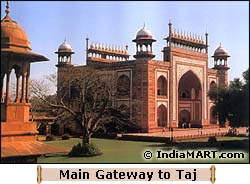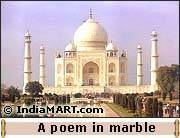|
INSIDE
THE TAJ

The
Main Gateway: Shah Jahan travelled
from the fort to the tomb by boat. Court histories describe his arrival
on the river side of the monument and his ascent to its terrace by way
of the embankment. This approach, however, was reserved for the emperor
and members of his party. Others passed through a large courtyard, a
jilokhana to enter the main gateway on the south. This courtyard was
a place where travellers halted. Here, also, the poor were provided
with food and shelter, and on every death anniversary of Mumtaz, vast
sums were distributed in charity.
Gate to Paradise: In this courtyard stand the main
gateway to the Taj and its gardens, a massive portal that opens to the
south. Detached gateways were long a traditional feature of Muslim architecture
and could be found fronting tombs and mosques throughout the East. Symbolically
to the Muslim, such an entrance way was the gate to Paradise. Metaphysically,
it represented the transition point between the outer world of the senses
and the inner world of the spirit.
Structure: Made of red sandstone, this 150 ft. wide
and nearly 100 ft. high, gateway consists of a lofty central arch with
double storeyed wings on either side. Octagonal towers are attached
to its corners which are surmounted by broad impressive open domed kiosks.
The most important feature of the gateway is a series of 11 attached
chhatris (umbrellas) with marble cupolas, flanked by pinnacles, above
the central portal on the north and south sides. A heavy door at the
base is made from 8 different metals and studded with knobs. Inside
are countless rooms with hallways that wind and divide in such apparent
abandon that they seem intentionally built to confuse; perhaps they
were, for they have remained unused for three centuries and their purpose
has long confounded the experts. Within the archway of this majestic
entrance, there is a large chamber with a vaulted roof.

Decoration: The gateway is richly embellished. Of particular
note are the floral arabesques fashioned from gemstones and inlaid in
white marble which decorate the spandrels of the arches. Also impressive
are the inlaid black marble inscriptions that frame the central vaulted
portal or iwan. These passages are excerpts from the Koran, which is
considered by Muslims to be the word of God as revealed to Mohammed.
It is here that Shah Jehan's calligraphers have performed an amazing
optical trick : the size of the lettering that runs up and over the
arch appears to be consistent from top to bottom. This illusion was
created by gradually heightening the size of the letters as their distance
from the eye increased; from the ground the dimensions seem the same
at every point. This effect is used with equal success on the main doorway
of the Taj itself.
Getting
There |Design
& Layout|Inside
the Taj |Taj
Mahal Pictures Gallery

Home Page
View
of Taj Mahal from different angles
|

